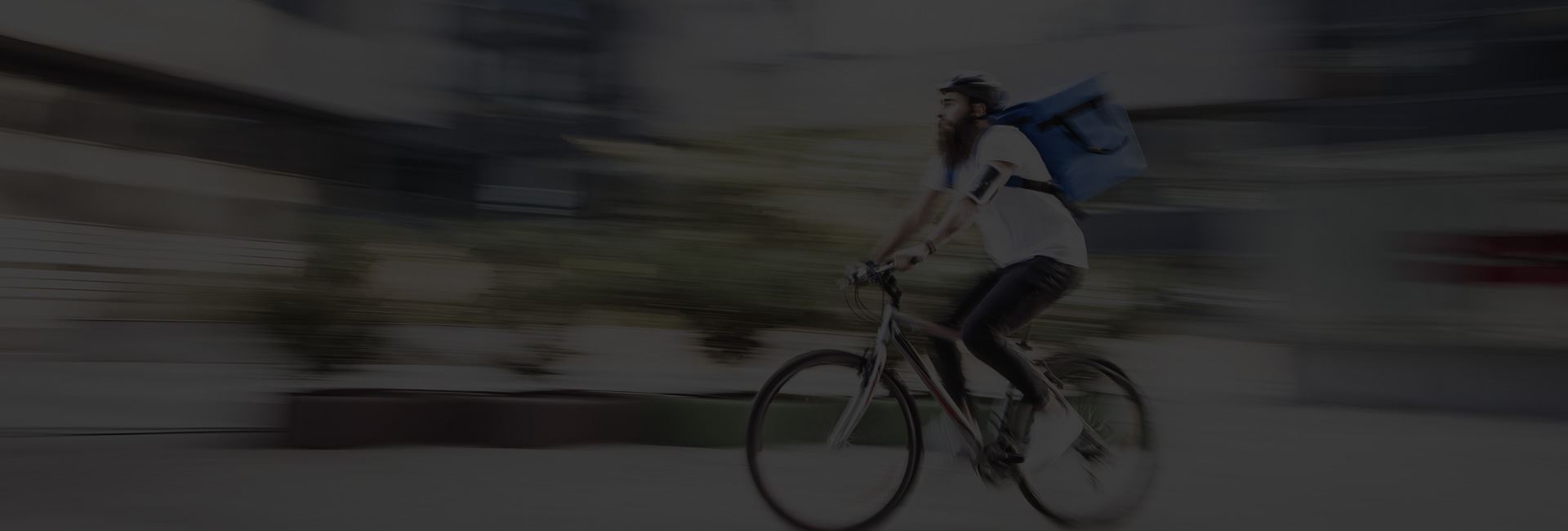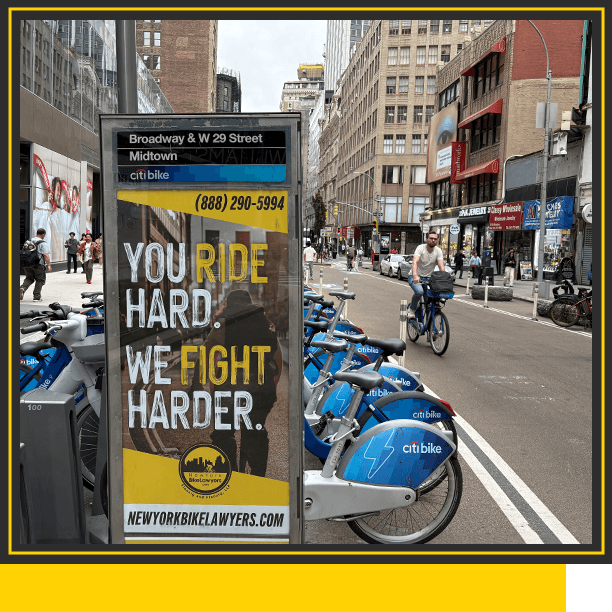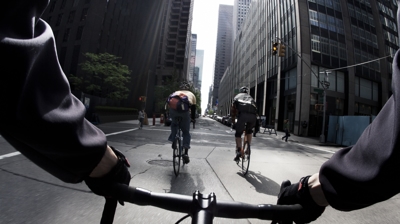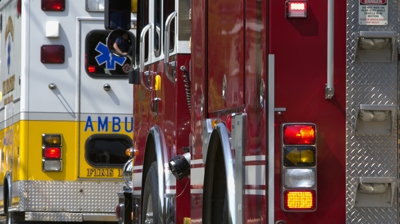
Bike Accidents Involving Street Defects, Pot Holes, and other Road Conditions
New York City Cyclists: Beware of Roadway Hazards
Street defects and other dangerous roadway conditions for cyclists include:
- Pot Holes
- Road Hardware such as Manhole Covers and Utility Vaults
- Construction Plates
- Road Cuts, Trenches, and other Temporary Paving
- Grates and Sewers
- Construction Debris and Negligently Placed Equipment
- Negligently Placed Dumpsters or Other Demolition Equipment
- Hummocks
- Ponding
- Improperly marked or placed speed bumps or speed humps
If you are a cyclist who suffers an collision as a result any of the above street conditions, we may be able to help. The most difficult case to prove is a case involving a pothole in a city street. In almost all cases in New York, you must prove that the City or Municipality had "prior written notice of the defect" before your accident occurred. However, if you can prove that the City of Municipality "affirmatively" created the condition, worked in the area, or otherwise had notice, you might be able to maintain a lawsuit. To learn more read our " Wheels of Justice" article on this issue by clicking here.
If you were involved in a crash due to a road defect, REPORT IT! Even if you were not hurt, by reporting it you help protect your fellow cyclists who may later face the same defect and not be so lucky. See a Street Defect, take a picture or video and report it!.
Identifying Ownership of NYC Road Hardware
Utility Companies normally have markings on street hardware. The markings are in the form of abbreviations, such as MGO or WSNY. For a list of typical markings, click here. There is no guarantee that the marking is accurate or that it demonstrates the true owner. Further investigation is always needed.
The law is different when it comes to road hardware, such as man holes and vaults that may be owned and maintained by private companies, municipal authorities, such as the Transit Authority, or utility providers such as Consolidated Edison (Con Ed) or Verizon. These entities are required by the New York City Administrative Code to maintain the area 12" inches around the structure, flush with the road surface. (11 RCNY2-14) This is what we call the 12" Rule, and it creates a basis for liability for the entity that owns and maintains the street hardware.
New York City's 12" Rule and Your Safety
Understanding Maintenance Obligations
(1) The owners of covers or gratings on a street are responsible for monitoring the condition of the covers and gratings and the area extending twelve inches outward from the perimeter of the hardware;
(2) The owners of covers and gratings shall replace or repair any cover or grating found to be defective, and shall repair any defective street condition found within an area extending twelve inches outward from the perimeter of the cover or grating.
(3) Street hardware shall be flush with the surrounding street surface. Street hardware which is greater than ½"above or below the street surface . . . shall be replaced or adjusted . . . ."
Securing Street Plates: A Contractor's Responsibility
Street opening plates (traffic plates) are required to be "pinned" in place so that they do not shift or move from vehicle traffic, and should ramped in order to keep them in secure positions, as well as a smooth transition as one traverses the plate. If a street opening is made by a contractor and plates are used, the responsibly to properly pin and ramp the plate, as well as to properly maintain the surrounding roadway, lies with the contractor.
In New York City roadway construction is highly regulated. Any contractor that opens a road way must have a Street Opening Permit. 34 RCNY 2-11(a). The use and installation of steel construction plates is also highly regulated. For example:
– Roadway construction plates “… shall have a skid-resistant surface equal to or greater than the adjacent existing street or roadway surface. The whole surface area of all plating and decking must be skid-resistant.” 34 RCNY 2-11(e)(10)(vi).
– Roadway construction plates must be, “… sufficiently ramped, covering all edges of the steel plates to provide smooth riding and safe condition.” 34 RCNY 2-11(e)(10)(i).
– All roadway construction plates “… must identify the name of the owner of such plating or decking. Identification must be made by welding or stamping the name of the owner onto the plating or decking.” 34 RCNY 2-11(e)(10)(viii).
– Roadway construction plates must be “… fastened by splicing, spiking, pinning, countersinking or otherwise protected to prevent movement.” 34 RCNY 2-11(e)(10)(iii).
– Roadway plates installed for use during the winter months shall have signs indicating the presence of “Steel Plates Ahead” and be countersunk flush to the level of the roadway. 34 RCNY 2-11(e)(10)(v).
By statute, a contractor working on a city street or sidewalk is required to keep all areas used by the public in a safe condition and it "shall be maintained free from debris, equipment, materials, projections or conditions that may cause a slipping, tripping or other hazard" In addition, "waste dumpsters and debris, debris boxes should be secured and those containing material or debris shall be covered at the end of each workday".
In one of our cases, we once represented a cyclist who was injured when the tarp on top of a dumpster was not properly secured and was allowed to blow loose and into the cyclist path. As a result, the cyclist lost control of his bike, crashed, and his ankle was run over by an unidentified truck. While we were never able to identify the truck that struck our client, we were successful in our suit against the contractor and building owner in the claim for negligent placement of the dumpster and the failure to secure the tarp.
Injured by NYC Road Defects? Contact Us for Legal Help
-
"Supported every step of the way."They handled everything with professionalism and care—communicating regularly, dealing with the insurance companies, and ultimately securing a settlement that truly reflected the pain and challenges I went through.- Danielle A.
-
"Dan and his team were supremely helpful."Dan took time to help explain the process and answer any questions I had while he was working on my case. I was very satisfied with his work and my settlement.- Max B.
-
"They know what they're doing!"They were an amazing team. Highly communicative, clear, intelligent, and able to get me results. They know what they're doing! Highly recommend.- Isabel M.
-
"From the first time I spoke with Daniel, I trusted him."I can't recommend Flanzig & Flanzig enough to anyone who has had a bike accident and needs legal assistance, you will definitely have peace of mind and feel taken care of.- N.B.
-
"It is obvious they are passionate about their work and care about their clients."Flanzig & Flanzig team are some of the most experienced and knowledgeable professionals you can find. I highly recommend working with them.- Addie M.
-
"Were with me every step of the way."If anything was unclear, they took the time to explain it thoroughly, and I always felt comfortable asking questions. Thank you again for your partnership. I would highly recommend them!- George E.
-
"Because I had Flanzig & Flanzig, I was able to focus on my healing and disability leave."Truthfully, I was unsure of what to do next, but thankfully, through Google search, I found Flanzig & Flanzig. I began working with Cathy, and so glad I did.- Melissa J.
-
"Total experts."Flanzig & Flanzig is THE law firm that can help you when you were involved in a bicycle crash. Total experts.- Wan P.


Why Choose Flanzig & Flanzig, LLP?
-
Leaders in the Safe Streets Movement
-
Committed Advocates for New York Cyclists
-
Top-Rated New York Attorneys
-
Dedicated to Helping Cyclists
-
Free Consultations




